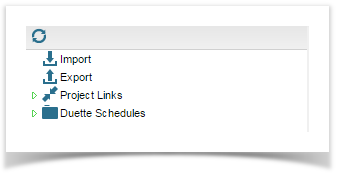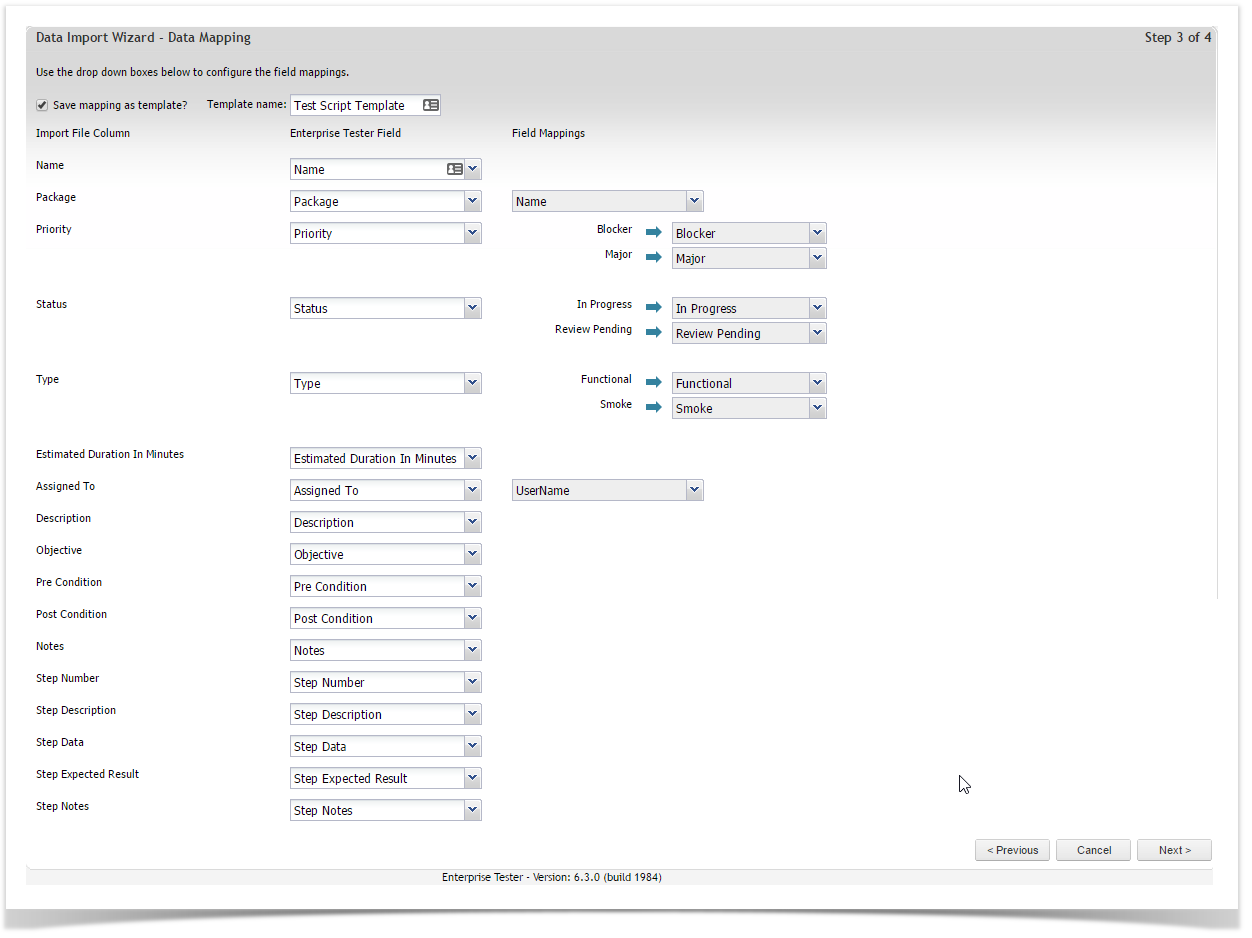A Requirement or Test Script, character separated values (CSV) file can be either created manually or exported from other systems.
Importing Requirements or Test Scripts via a CSV file is an effective method to create entities in bulk within Enterprise Tester.
You can import data to either Create or Update Requirements and Test Scripts.
Preparing your CSV file
Creating a CSV file:
- If this is the first time you are importing a CSV file into Enterprise Tester , the easiest way to do this is to Export - (see Export Data) a Requirement or Test Script first.
This will give you a template with the correct format, including headers that you can modify and import.
- Example Requirement and Test Script CSV files
Example Requirements Import file.csv
Example Test Script Import file.csv
- Any other fields, including Custom fields can be added as columns to the CSV file and imported if required.
- At a minimum your CSV file must contain the following fields (mandatory fields may change depending on your specific Field Configuration settings in the Admin tab):
- For creating Requirements and Test Scripts - Name field is required
- For updating Requirements and Test Scripts - Id and Name fields are required.
Headers:
The header is the Name of the corresponding field in Enterprise Tester.
- Having a header row in your CSV file is recommended, as it makes the mapping process much simpler.
- Ensure that no two columns have the same headers.
Commonly used headers for Requirements | |||
Header Name | Description | Notes | Example data |
|---|---|---|---|
| Id | Enterprise Tester GUID identifier |
| {4c5d76e4-a21e-4f95-965a-a6890101a4cc} |
| Name | Name of the requirement |
| Fast Cash |
| Package | Name of the package(s) |
| Requirements|Cash Withdrawal|Fast Cash Requirements is the root package of the data. |
| Description | Description of the requirement |
| The customer should be able to select an amount and the money will be supplied if they have it in any of their accounts. |
| Difficulty Level | Difficulty of the requirement |
| Low |
| Priority | Priority of the requirement |
| Major |
| Status | Status of the requirement |
| In Progress |
| Type | Type of requirement |
| Story |
| Assigned to | User who the requirement is assigned to |
| smithl |
Commonly used headers in Test Scripts | |||
Header Name | Description | Notes | Example Data |
|---|---|---|---|
| Id | Enterprise Tester GUID identifier |
| {f9778744-1914-4e37-847e-a6890101fb68} |
| Name | Name of the Test Script |
| Customer Validated |
| Package | Name of the package(s) |
| Script Library|Access ATM |
| Priority | Priority of the test script |
| Major |
| Status | Status of the test script |
| In Progress |
| Type | Type of test script |
| Functional |
| Estimated Duration in Minutes | Estimated time it will take to execute the test script (in minutes) |
| 7350 This will be converted to 3 weeks, 2 hours, 30 minutes using the default Enterprise Tester settings. |
| Assigned To | User who the test script is assigned to |
| Smithl |
| Description | Description of the test script |
| This is where the card and pin are correct as the customer is given access to the ATM |
| Objective | Objective of the test script |
| Customer can access ATM using card with correct pin number |
| Pre Condition | Pre Condition of the test script |
| Card has pin already loaded |
| Post Condition | Post Condition of the test script |
| Card is returned to customer |
| Notes | Notes for the the test script |
| The goal of the Customer is to access the ATM so that they can complete a transaction |
| Step Number | Test step number |
| 1 |
| Step Description | Test step description |
| Customer inserts card into ATM |
| Step Expected Result | Test step expected result |
| ATM Accepts Card |
| Step Data | Test step data |
| Type of card = Cashflow Account Type = Savings |
| Step Notes | Test step notes |
| Ensure Card is of type cashflow, not debit or credit card |
More tips:
- Enterprise Tester will automatically import your records in the same order they appear in the CSV file. If you wish to control the order in which records are imported, add a column to your CSV file called Order Number and number records in the order you would like them to appear.
- Breaking entities into packages of less than 200 individual items will ensure optimal performance.
- Field mappings must be one-to-one, two import fields cannot map to one Enterprise Tester field.
- Some fields will prompt you for additional information pertaining to that field e.g. you will be asked to indicate if the value in the CSV file is the package name or ID.
- You must supply the ID if you are updating fields
- You must NOT supply the ID if you want to create new Requirements or Test Scripts.
- If you do map the ID field then every entity must have an ID. You cannot update and create new during the same import.
- You cannot blank out a mapping once it has been made without restarting the entire wizard.
- An invalid ID number will cause your import to fail. In all other instances, leave ID blank or exclude from your import CSV.
Start CSV Import
Select the Resources tab and double click Import.
Select the Project you would like to import your data to and the Type of data to be imported (Requirements or Test Scripts).
Browse to your CSV file and specify if the file contains a header row, then click on Next.
The application will read the CSV file and the Data Mapping screen will be displayed.
- The "Save mapping as a template?" check box will allow you to save and reuse the mappings. Add a Template Name when this is ticked.
- The Import File (on the left hand side) displays the columns (headers) from the file that you are importing.
- The Enterprise Tester Field (on the right hand side) lets you select fields from Enterprise Tester.
Use the drop down boxes to map the Import File fields to the Enterprise Tester Field.
Once the fields have been mapped, click on Next at the bottom of the page, followed by Yes to begin importing.
When the import is complete the following status window will appear. If there have been errors, click on the click here to view the error log link for information on why the export failed. If the export was successful, click Cancel.
To view the imported Requirements or Test Scripts, select the Explorer tab and open the relevant folder.
Re-using Saved Templates
When you have previously saved mappings as a template, you can re-use these as follows:
- Select your CSV file as per the usual process
- Highlight the required mapping template
- Click the Next button
The mappings will be automatically loaded.
Update Data By Importing a CSV File
Updating Requirements or Test Scripts by importing a CSV file is similar to creating new data. Some additional points to note are:
- A unique ID or GUID is required in the CSV file so Enterprise Tester can match the records that need to be updated.
- To obtain the ID or GUID, perform an export of the records you want to update and include the ID column in the export.
- When importing the data make sure the ID and any fields that need updating are included in the CSV file.






